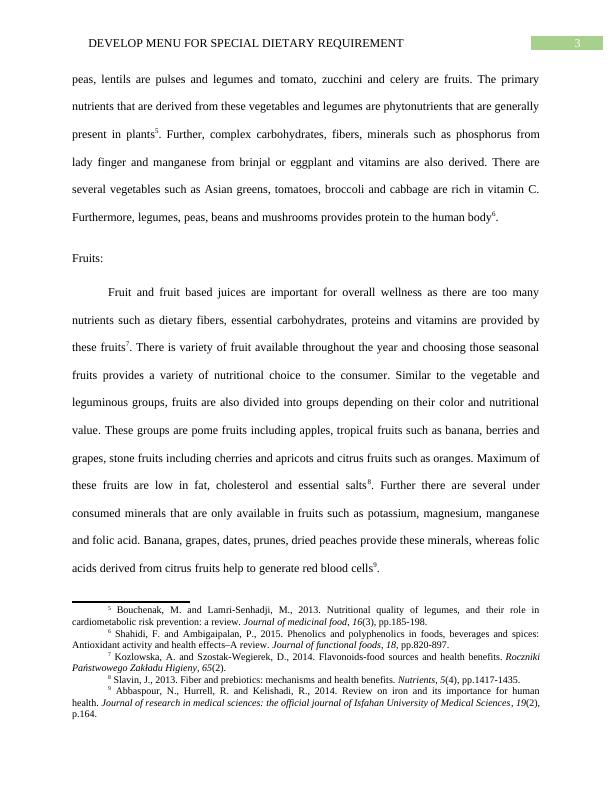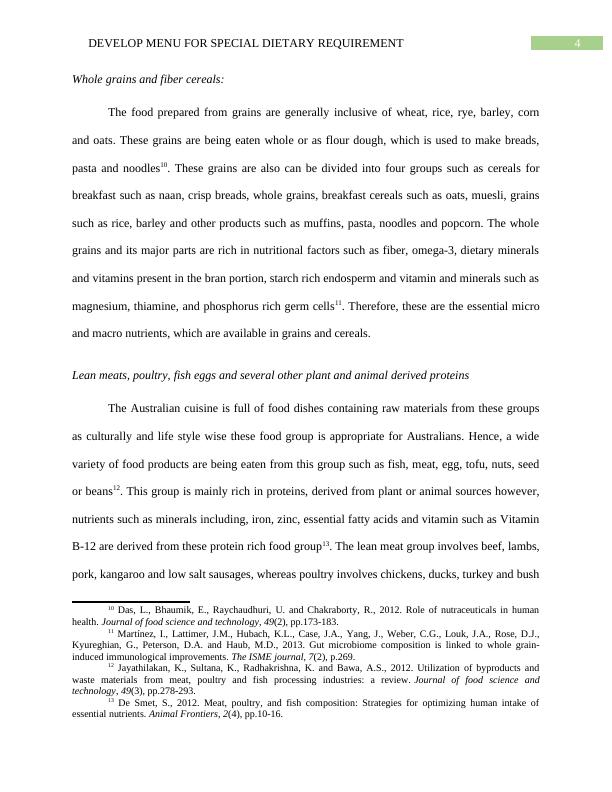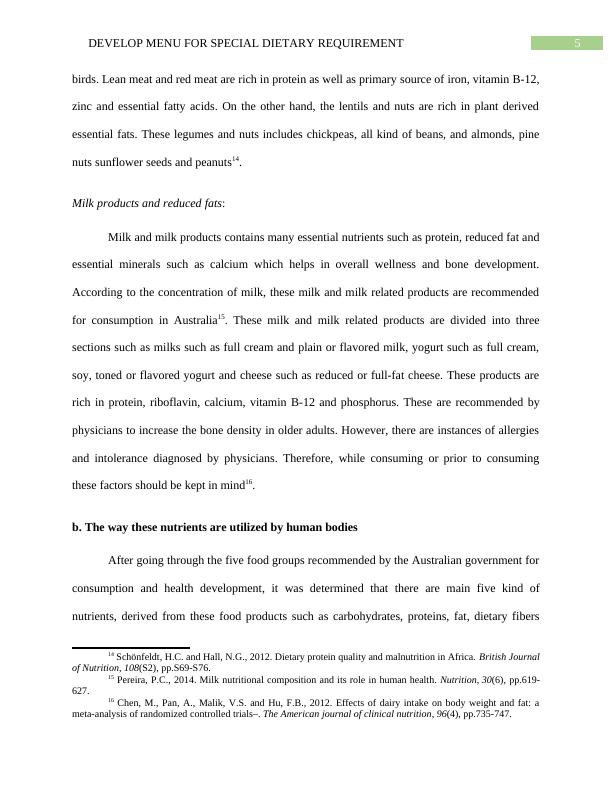Develop menus for special dietary requirement
25 Pages6031 Words25 Views
Added on 2021-04-24
Develop menus for special dietary requirement
Added on 2021-04-24
ShareRelated Documents
Running head: DEVELOP MENU FOR SPECIAL DIETARY REQUIREMENT
DEVELOP MENU FOR SPECIAL DIETARY REQUIREMENT
Name of the Student
Name of the University
Author note
DEVELOP MENU FOR SPECIAL DIETARY REQUIREMENT
Name of the Student
Name of the University
Author note

1DEVELOP MENU FOR SPECIAL DIETARY REQUIREMENT

2DEVELOP MENU FOR SPECIAL DIETARY REQUIREMENT
Part A
a. Five food groups
Good and healthy diet is an important aspect that helps to lead a healthy and balanced
life. The food and drink combined with proper physical activity help to maintain body weight
and prevent several diseases such as obesity and diabetes1. There is a variety of food products
that helps us to gain basic nutrients for healthy body such as carbohydrate, proteins, fat,
minerals, fibers and essential micro-nutrient. However, According to Australian dietary
guidelines these variety of the food products belong to “five food groups” and according to this
guideline these five food groups makes Australian healthy eating guideline2. These food items
has been grouped together because they provide similar key nutrients after being broken down
into the human body. These five food groups are: vegetable and legumes, fruit, grain (whole
grain and fibrous cereals), lean meat, poultry, tofu, nuts beans and legume and reduced fats,
milk, yogurt and cheese3.
Vegetable and legumes:
Eating healthy and colorful vegetable reduces the risk of cardiovascular as well as risk of
strokes and obesity. The edible vegetables belongs to several part of the respective plant such as
leaves, stem, fruit, seeds, legumes, roots, tuber and flowers4. For example, potatoes, carrots and
beetroot are roots and tubers, cauliflower, broccoli and cabbages are flowers, kidney beans, chick
1 Ayesha Sherzai et al, Stroke, Food Groups, And Dietary Patterns: A Systematic Review (2012) Nutrition
reviews <https://academic.oup.com/nutritionreviews/article/70/8/423/1853963>.
2 Malek, L., Umberger, W., Makrides, M. and Zhou, S.J., 2016. Adherence to the Australian dietary
guidelines during pregnancy: evidence from a national study. Public health nutrition, 19(7), pp.1155-1163.
3 Ralston, R.A., Lee, J.H., Truby, H., Palermo, C.E. and Walker, K.Z., 2012. A systematic review and
meta-analysis of elevated blood pressure and consumption of dairy foods. Journal of human hypertension, 26(1),
p.3. 4 Rubatzky, V.E. and Yamaguchi, M., 2012. World vegetables: principles, production, and nutritive values.
Springer Science & Business Media.
Part A
a. Five food groups
Good and healthy diet is an important aspect that helps to lead a healthy and balanced
life. The food and drink combined with proper physical activity help to maintain body weight
and prevent several diseases such as obesity and diabetes1. There is a variety of food products
that helps us to gain basic nutrients for healthy body such as carbohydrate, proteins, fat,
minerals, fibers and essential micro-nutrient. However, According to Australian dietary
guidelines these variety of the food products belong to “five food groups” and according to this
guideline these five food groups makes Australian healthy eating guideline2. These food items
has been grouped together because they provide similar key nutrients after being broken down
into the human body. These five food groups are: vegetable and legumes, fruit, grain (whole
grain and fibrous cereals), lean meat, poultry, tofu, nuts beans and legume and reduced fats,
milk, yogurt and cheese3.
Vegetable and legumes:
Eating healthy and colorful vegetable reduces the risk of cardiovascular as well as risk of
strokes and obesity. The edible vegetables belongs to several part of the respective plant such as
leaves, stem, fruit, seeds, legumes, roots, tuber and flowers4. For example, potatoes, carrots and
beetroot are roots and tubers, cauliflower, broccoli and cabbages are flowers, kidney beans, chick
1 Ayesha Sherzai et al, Stroke, Food Groups, And Dietary Patterns: A Systematic Review (2012) Nutrition
reviews <https://academic.oup.com/nutritionreviews/article/70/8/423/1853963>.
2 Malek, L., Umberger, W., Makrides, M. and Zhou, S.J., 2016. Adherence to the Australian dietary
guidelines during pregnancy: evidence from a national study. Public health nutrition, 19(7), pp.1155-1163.
3 Ralston, R.A., Lee, J.H., Truby, H., Palermo, C.E. and Walker, K.Z., 2012. A systematic review and
meta-analysis of elevated blood pressure and consumption of dairy foods. Journal of human hypertension, 26(1),
p.3. 4 Rubatzky, V.E. and Yamaguchi, M., 2012. World vegetables: principles, production, and nutritive values.
Springer Science & Business Media.

3DEVELOP MENU FOR SPECIAL DIETARY REQUIREMENT
peas, lentils are pulses and legumes and tomato, zucchini and celery are fruits. The primary
nutrients that are derived from these vegetables and legumes are phytonutrients that are generally
present in plants5. Further, complex carbohydrates, fibers, minerals such as phosphorus from
lady finger and manganese from brinjal or eggplant and vitamins are also derived. There are
several vegetables such as Asian greens, tomatoes, broccoli and cabbage are rich in vitamin C.
Furthermore, legumes, peas, beans and mushrooms provides protein to the human body6.
Fruits:
Fruit and fruit based juices are important for overall wellness as there are too many
nutrients such as dietary fibers, essential carbohydrates, proteins and vitamins are provided by
these fruits7. There is variety of fruit available throughout the year and choosing those seasonal
fruits provides a variety of nutritional choice to the consumer. Similar to the vegetable and
leguminous groups, fruits are also divided into groups depending on their color and nutritional
value. These groups are pome fruits including apples, tropical fruits such as banana, berries and
grapes, stone fruits including cherries and apricots and citrus fruits such as oranges. Maximum of
these fruits are low in fat, cholesterol and essential salts8. Further there are several under
consumed minerals that are only available in fruits such as potassium, magnesium, manganese
and folic acid. Banana, grapes, dates, prunes, dried peaches provide these minerals, whereas folic
acids derived from citrus fruits help to generate red blood cells9.
5 Bouchenak, M. and Lamri-Senhadji, M., 2013. Nutritional quality of legumes, and their role in
cardiometabolic risk prevention: a review. Journal of medicinal food, 16(3), pp.185-198.
6 Shahidi, F. and Ambigaipalan, P., 2015. Phenolics and polyphenolics in foods, beverages and spices:
Antioxidant activity and health effects–A review. Journal of functional foods, 18, pp.820-897.
7 Kozlowska, A. and Szostak-Wegierek, D., 2014. Flavonoids-food sources and health benefits. Roczniki
Państwowego Zakładu Higieny, 65(2).
8 Slavin, J., 2013. Fiber and prebiotics: mechanisms and health benefits. Nutrients, 5(4), pp.1417-1435.
9 Abbaspour, N., Hurrell, R. and Kelishadi, R., 2014. Review on iron and its importance for human
health. Journal of research in medical sciences: the official journal of Isfahan University of Medical Sciences, 19(2),
p.164.
peas, lentils are pulses and legumes and tomato, zucchini and celery are fruits. The primary
nutrients that are derived from these vegetables and legumes are phytonutrients that are generally
present in plants5. Further, complex carbohydrates, fibers, minerals such as phosphorus from
lady finger and manganese from brinjal or eggplant and vitamins are also derived. There are
several vegetables such as Asian greens, tomatoes, broccoli and cabbage are rich in vitamin C.
Furthermore, legumes, peas, beans and mushrooms provides protein to the human body6.
Fruits:
Fruit and fruit based juices are important for overall wellness as there are too many
nutrients such as dietary fibers, essential carbohydrates, proteins and vitamins are provided by
these fruits7. There is variety of fruit available throughout the year and choosing those seasonal
fruits provides a variety of nutritional choice to the consumer. Similar to the vegetable and
leguminous groups, fruits are also divided into groups depending on their color and nutritional
value. These groups are pome fruits including apples, tropical fruits such as banana, berries and
grapes, stone fruits including cherries and apricots and citrus fruits such as oranges. Maximum of
these fruits are low in fat, cholesterol and essential salts8. Further there are several under
consumed minerals that are only available in fruits such as potassium, magnesium, manganese
and folic acid. Banana, grapes, dates, prunes, dried peaches provide these minerals, whereas folic
acids derived from citrus fruits help to generate red blood cells9.
5 Bouchenak, M. and Lamri-Senhadji, M., 2013. Nutritional quality of legumes, and their role in
cardiometabolic risk prevention: a review. Journal of medicinal food, 16(3), pp.185-198.
6 Shahidi, F. and Ambigaipalan, P., 2015. Phenolics and polyphenolics in foods, beverages and spices:
Antioxidant activity and health effects–A review. Journal of functional foods, 18, pp.820-897.
7 Kozlowska, A. and Szostak-Wegierek, D., 2014. Flavonoids-food sources and health benefits. Roczniki
Państwowego Zakładu Higieny, 65(2).
8 Slavin, J., 2013. Fiber and prebiotics: mechanisms and health benefits. Nutrients, 5(4), pp.1417-1435.
9 Abbaspour, N., Hurrell, R. and Kelishadi, R., 2014. Review on iron and its importance for human
health. Journal of research in medical sciences: the official journal of Isfahan University of Medical Sciences, 19(2),
p.164.

4DEVELOP MENU FOR SPECIAL DIETARY REQUIREMENT
Whole grains and fiber cereals:
The food prepared from grains are generally inclusive of wheat, rice, rye, barley, corn
and oats. These grains are being eaten whole or as flour dough, which is used to make breads,
pasta and noodles10. These grains are also can be divided into four groups such as cereals for
breakfast such as naan, crisp breads, whole grains, breakfast cereals such as oats, muesli, grains
such as rice, barley and other products such as muffins, pasta, noodles and popcorn. The whole
grains and its major parts are rich in nutritional factors such as fiber, omega-3, dietary minerals
and vitamins present in the bran portion, starch rich endosperm and vitamin and minerals such as
magnesium, thiamine, and phosphorus rich germ cells11. Therefore, these are the essential micro
and macro nutrients, which are available in grains and cereals.
Lean meats, poultry, fish eggs and several other plant and animal derived proteins
The Australian cuisine is full of food dishes containing raw materials from these groups
as culturally and life style wise these food group is appropriate for Australians. Hence, a wide
variety of food products are being eaten from this group such as fish, meat, egg, tofu, nuts, seed
or beans12. This group is mainly rich in proteins, derived from plant or animal sources however,
nutrients such as minerals including, iron, zinc, essential fatty acids and vitamin such as Vitamin
B-12 are derived from these protein rich food group13. The lean meat group involves beef, lambs,
pork, kangaroo and low salt sausages, whereas poultry involves chickens, ducks, turkey and bush
10 Das, L., Bhaumik, E., Raychaudhuri, U. and Chakraborty, R., 2012. Role of nutraceuticals in human
health. Journal of food science and technology, 49(2), pp.173-183.
11 Martínez, I., Lattimer, J.M., Hubach, K.L., Case, J.A., Yang, J., Weber, C.G., Louk, J.A., Rose, D.J.,
Kyureghian, G., Peterson, D.A. and Haub, M.D., 2013. Gut microbiome composition is linked to whole grain-
induced immunological improvements. The ISME journal, 7(2), p.269.
12 Jayathilakan, K., Sultana, K., Radhakrishna, K. and Bawa, A.S., 2012. Utilization of byproducts and
waste materials from meat, poultry and fish processing industries: a review. Journal of food science and
technology, 49(3), pp.278-293.
13 De Smet, S., 2012. Meat, poultry, and fish composition: Strategies for optimizing human intake of
essential nutrients. Animal Frontiers, 2(4), pp.10-16.
Whole grains and fiber cereals:
The food prepared from grains are generally inclusive of wheat, rice, rye, barley, corn
and oats. These grains are being eaten whole or as flour dough, which is used to make breads,
pasta and noodles10. These grains are also can be divided into four groups such as cereals for
breakfast such as naan, crisp breads, whole grains, breakfast cereals such as oats, muesli, grains
such as rice, barley and other products such as muffins, pasta, noodles and popcorn. The whole
grains and its major parts are rich in nutritional factors such as fiber, omega-3, dietary minerals
and vitamins present in the bran portion, starch rich endosperm and vitamin and minerals such as
magnesium, thiamine, and phosphorus rich germ cells11. Therefore, these are the essential micro
and macro nutrients, which are available in grains and cereals.
Lean meats, poultry, fish eggs and several other plant and animal derived proteins
The Australian cuisine is full of food dishes containing raw materials from these groups
as culturally and life style wise these food group is appropriate for Australians. Hence, a wide
variety of food products are being eaten from this group such as fish, meat, egg, tofu, nuts, seed
or beans12. This group is mainly rich in proteins, derived from plant or animal sources however,
nutrients such as minerals including, iron, zinc, essential fatty acids and vitamin such as Vitamin
B-12 are derived from these protein rich food group13. The lean meat group involves beef, lambs,
pork, kangaroo and low salt sausages, whereas poultry involves chickens, ducks, turkey and bush
10 Das, L., Bhaumik, E., Raychaudhuri, U. and Chakraborty, R., 2012. Role of nutraceuticals in human
health. Journal of food science and technology, 49(2), pp.173-183.
11 Martínez, I., Lattimer, J.M., Hubach, K.L., Case, J.A., Yang, J., Weber, C.G., Louk, J.A., Rose, D.J.,
Kyureghian, G., Peterson, D.A. and Haub, M.D., 2013. Gut microbiome composition is linked to whole grain-
induced immunological improvements. The ISME journal, 7(2), p.269.
12 Jayathilakan, K., Sultana, K., Radhakrishna, K. and Bawa, A.S., 2012. Utilization of byproducts and
waste materials from meat, poultry and fish processing industries: a review. Journal of food science and
technology, 49(3), pp.278-293.
13 De Smet, S., 2012. Meat, poultry, and fish composition: Strategies for optimizing human intake of
essential nutrients. Animal Frontiers, 2(4), pp.10-16.

5DEVELOP MENU FOR SPECIAL DIETARY REQUIREMENT
birds. Lean meat and red meat are rich in protein as well as primary source of iron, vitamin B-12,
zinc and essential fatty acids. On the other hand, the lentils and nuts are rich in plant derived
essential fats. These legumes and nuts includes chickpeas, all kind of beans, and almonds, pine
nuts sunflower seeds and peanuts14.
Milk products and reduced fats:
Milk and milk products contains many essential nutrients such as protein, reduced fat and
essential minerals such as calcium which helps in overall wellness and bone development.
According to the concentration of milk, these milk and milk related products are recommended
for consumption in Australia15. These milk and milk related products are divided into three
sections such as milks such as full cream and plain or flavored milk, yogurt such as full cream,
soy, toned or flavored yogurt and cheese such as reduced or full-fat cheese. These products are
rich in protein, riboflavin, calcium, vitamin B-12 and phosphorus. These are recommended by
physicians to increase the bone density in older adults. However, there are instances of allergies
and intolerance diagnosed by physicians. Therefore, while consuming or prior to consuming
these factors should be kept in mind16.
b. The way these nutrients are utilized by human bodies
After going through the five food groups recommended by the Australian government for
consumption and health development, it was determined that there are main five kind of
nutrients, derived from these food products such as carbohydrates, proteins, fat, dietary fibers
14 Schönfeldt, H.C. and Hall, N.G., 2012. Dietary protein quality and malnutrition in Africa. British Journal
of Nutrition, 108(S2), pp.S69-S76.
15 Pereira, P.C., 2014. Milk nutritional composition and its role in human health. Nutrition, 30(6), pp.619-
627. 16 Chen, M., Pan, A., Malik, V.S. and Hu, F.B., 2012. Effects of dairy intake on body weight and fat: a
meta-analysis of randomized controlled trials–. The American journal of clinical nutrition, 96(4), pp.735-747.
birds. Lean meat and red meat are rich in protein as well as primary source of iron, vitamin B-12,
zinc and essential fatty acids. On the other hand, the lentils and nuts are rich in plant derived
essential fats. These legumes and nuts includes chickpeas, all kind of beans, and almonds, pine
nuts sunflower seeds and peanuts14.
Milk products and reduced fats:
Milk and milk products contains many essential nutrients such as protein, reduced fat and
essential minerals such as calcium which helps in overall wellness and bone development.
According to the concentration of milk, these milk and milk related products are recommended
for consumption in Australia15. These milk and milk related products are divided into three
sections such as milks such as full cream and plain or flavored milk, yogurt such as full cream,
soy, toned or flavored yogurt and cheese such as reduced or full-fat cheese. These products are
rich in protein, riboflavin, calcium, vitamin B-12 and phosphorus. These are recommended by
physicians to increase the bone density in older adults. However, there are instances of allergies
and intolerance diagnosed by physicians. Therefore, while consuming or prior to consuming
these factors should be kept in mind16.
b. The way these nutrients are utilized by human bodies
After going through the five food groups recommended by the Australian government for
consumption and health development, it was determined that there are main five kind of
nutrients, derived from these food products such as carbohydrates, proteins, fat, dietary fibers
14 Schönfeldt, H.C. and Hall, N.G., 2012. Dietary protein quality and malnutrition in Africa. British Journal
of Nutrition, 108(S2), pp.S69-S76.
15 Pereira, P.C., 2014. Milk nutritional composition and its role in human health. Nutrition, 30(6), pp.619-
627. 16 Chen, M., Pan, A., Malik, V.S. and Hu, F.B., 2012. Effects of dairy intake on body weight and fat: a
meta-analysis of randomized controlled trials–. The American journal of clinical nutrition, 96(4), pp.735-747.

End of preview
Want to access all the pages? Upload your documents or become a member.
Related Documents
Nutritional Value of Food Groups and Dietary Requirements for Childrenlg...
|9
|2816
|238
Nutrition Intervention and Planninglg...
|41
|1271
|48
Commercial Cookerylg...
|22
|5760
|90
Diet Analysis and Discussion on Human Nutrition and Foodlg...
|5
|2001
|63
Questions on Healthcare 2022lg...
|13
|3530
|19
Assessment on Nutrition (Doc)lg...
|10
|2659
|113
